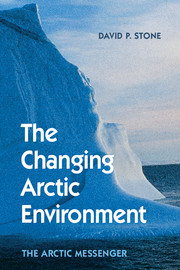Book contents
- Frontmatter
- Dedication
- Contents
- Acknowledgements
- Acronyms
- 1 Personal Beginnings
- PART I THE CHANGING ARCTIC
- PART II WORKING TOGETHER
- PART III WHAT IS THE PRESENT STATE OF KNOWLEDGE?
- 4 Radioactivity
- 5 Heroic Efforts
- 6 Acidification and Arctic Haze
- 7 Stratospheric Ozone Depletion
- 8 Persistent Organic Pollutants and Heavy Metals (Including Mercury)
- 9 Conducting Marine Science in the Arctic
- 10 Climate Change in the Arctic
- PART IV WHAT DOES ALL THIS MEAN?
- Appendix I The Intergovernmental Panel on Climate Change (IPCC)
- Appendix II What Will Happen in the Future If We Do Nothing or If We Try Very Hard to Aggressively Reduce GHG Emissions: Projected Change Under Different Emission Scenarios
- Appendix III Some Geophysical Background Notes Related to Climate and Weather
- Appendix IV Orbital Forcing
- Appendix V The Concept of Commitment
- Bibliography
- Credits
- Index
6 - Acidification and Arctic Haze
from PART III - WHAT IS THE PRESENT STATE OF KNOWLEDGE?
Published online by Cambridge University Press: 05 February 2015
- Frontmatter
- Dedication
- Contents
- Acknowledgements
- Acronyms
- 1 Personal Beginnings
- PART I THE CHANGING ARCTIC
- PART II WORKING TOGETHER
- PART III WHAT IS THE PRESENT STATE OF KNOWLEDGE?
- 4 Radioactivity
- 5 Heroic Efforts
- 6 Acidification and Arctic Haze
- 7 Stratospheric Ozone Depletion
- 8 Persistent Organic Pollutants and Heavy Metals (Including Mercury)
- 9 Conducting Marine Science in the Arctic
- 10 Climate Change in the Arctic
- PART IV WHAT DOES ALL THIS MEAN?
- Appendix I The Intergovernmental Panel on Climate Change (IPCC)
- Appendix II What Will Happen in the Future If We Do Nothing or If We Try Very Hard to Aggressively Reduce GHG Emissions: Projected Change Under Different Emission Scenarios
- Appendix III Some Geophysical Background Notes Related to Climate and Weather
- Appendix IV Orbital Forcing
- Appendix V The Concept of Commitment
- Bibliography
- Credits
- Index
Summary
Casca: “I durst not laugh for fear of opening my lips and receiving the bad air”.
William Shakespeare, Julius CaesarBefore we start, here is another simple revision of our school chemistry. Water molecules exist in equilibrium with hydrogen ions H+ and hydroxide ions OH-.
H2O <–> H+ + OH-
A solution is acidic if the H+ ions are in excess and is basic (or alkaline) if the OH- ions are in excess. The pH scale is used to measure the acidity of a substance. The scale ranges from 0 to 14. A pH value of 7 is neutral. A value of less than 7 is acidic and a value greater than 7 is basic. It is a logarithmic scale. Therefore, pH 5 is 10 times more acidic than pH 6 and 100 times more acidic than the neutral pH 7. Normal rain has a pH of about 5.6 due to an interaction with carbon dioxide, which results in the formation of carbonic acid.
With this technicality over, the acidification story can begin. In Part 1, we briefly noted that in the 1960s, terrestrial and freshwater ecologists began to describe widespread deterioration of forests and freshwater ecosystems in northern Europe, eastern Canada, and northeastern United States. The cause was quickly identified. Sulphur and nitrogen oxides released from combustion sources were reacting with water in the atmosphere to form acids of nitrogen and sulphur that increased the acidity of rain and snow. It was probably the first time the general public heard the phrase acid rain.
It is worth pausing for a moment to appreciate several of the then unique features of this situation. First, the sources of the offending sulphur and nitrogen were ubiquitous and included nonferrous metal smelting and the combustion of hydrocarbons, ranging in scope from industrial scale activities (including electrical power generation) to automobile exhaust and also at that time from domestic heating. Coal was a particularly significant source.
- Type
- Chapter
- Information
- The Changing Arctic EnvironmentThe Arctic Messenger, pp. 76 - 84Publisher: Cambridge University PressPrint publication year: 2015



